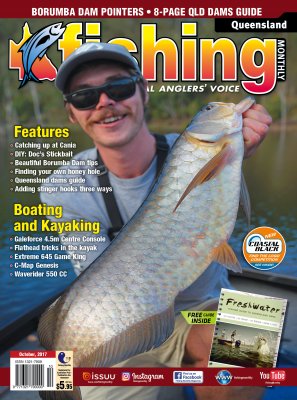Tips and tricks for finding your own spots by Dave Hodge
 There's no doubt in the world that the population of lure fishers in the north is on the rise, and if you're anything like me then sitting in the middle of a heap of boats is not your idea of fun. Fortunately, it's not always hard to find your own locations for a variety of species, so here are a few hints to help you start the search.
There's no doubt in the world that the population of lure fishers in the north is on the rise, and if you're anything like me then sitting in the middle of a heap of boats is not your idea of fun. Fortunately, it's not always hard to find your own locations for a variety of species, so here are a few hints to help you start the search.
For me, offshore fishing is mostly reserved for when I go with mates who own bigger boats, so the distant reefs are not an option for the young fella and I. When looking for areas in our range, the number one tool for me is good old Google Earth. Apart from finding launching spots, it often shows inshore reefs, contours, creeks and rivers and how long the system is. Some creeks are only 1-2km long, while others go much, much further. It also shows me which river mouths have sand bars to access the open water.
I only have a small boat - a Polycraft Challenger 4.1 with a 50 Honda 4-stroke on it, so calm weather is a prerequisite for anything outside of the rivers. Once I have found an interesting looking area and the nearest launch site, I use the Navionics app on my phone to research a potential area in more detail.
At the first opportunity I put those coordinates into the GPS, then I head out and use the side scan on my sounder to methodically scan and mark any drop-offs, snags, reefs and so on, where current lines may hold bait and ultimately attract predators. I pick out several potential areas, and bring a range of lures appropriate for a few different species including barra, golden snapper (fingermark), grunter, jacks, trout, GTs, queenfish and more.
TROLLING LURES OUTSIDE THE RIVERS
Luckily it only takes a few different lures to cover all of these species, and it's more a matter of what size tackle and jigheads will be used to catch whatever's available.
Trolling hardbodies is one very effective way to explore the depths for golden snapper, trout and big barra. If you're fishing 8-10m, having a lure like the 8m Halco Scorpion pulsing away out the back will be a great way to cover water and find out what's happening.
I find early morning is the best time to do this, as the wind is usually at its weakest then. You may be surprised at how big a fish will be close to shore. If the water's a little shallower then a Poltergeist 80mm 5m diver is a good one, particularly if there is rock, reef or snags around, because they jump structure very well. Due to the potentially big fish you can intercept doing this, a minimum of 20-30lb braid is best with around 2m of 40lb leader.
VERSATILE SOFT PLASTICS
Some species don't like to eat bigger food items, and typically these species aren't equipped to tear things apart into bite-sized pieces. The highly regarded grunter are one such species, and with a relatively small mouth in comparison to their body, these fish are best targeted with smaller prawn or squid lures. If you're a bait fisher, real prawns or squid will do the job.
If you're on a shoal type of bottom or shell beds, light line and leaders will get you more bites without the need to stop fish as quickly, as you often would with structure or reefs. If you're really prepared you'll have some livies in the tank, and these won't last long if there are fish about.
One of our fall-back techniques is to use a light 6'6 to 7ft spin rod in around the 8-16lb rating, a 2000-3000 sized spin reel spooled with line of 6-10lb breaking strain and a fluorocarbon leader of 15-30lb. If the water's clear - as is the often case in winter - then long leaders of around 2-3m work best. If it's murky, 1.5-2m will do.
Jighead choice depends on water depth and flow speed. Once you've marked a likely spot or a school of fish, position yourself down current of the target and cast back past the spot, allowing the lure to sink to the bottom. Then hop the lure through the strike zone keeping in contact with the bottom for the duration of the retrieve.
Bites from grunter can range from gentle little tapping sensations through the rod, to slamming strikes pulling line instantly. Regardless, you need to set that hook and a soft tipped rod won't straighten or pull the hooks, so don't be afraid to 'give it some' on the strike. You also don't want a fish to eject it if they feel wary, so the sharpest possible hooks are the go.
The 3" Atomic Prongs or Plazo paddle-tails work well matched with a 1/4oz Atomic Seeker head and a no. 1 or 2 hook size. Another proven producer is the 5" Madeyes Paddle Prawn, and the best head I have found for these in the shallower scenarios is the 1/3oz Atomic Seeker with a 2/0 to 4/0 hook.
Another benefit of the Seeker is the retaining collars that hold the plastic in place when considerable effort is put into a cast, and during the retrieve. This is very important with any of the new age RST constructed lures, as they can slip down the hook during the cast or after a bite with a less defined collar.